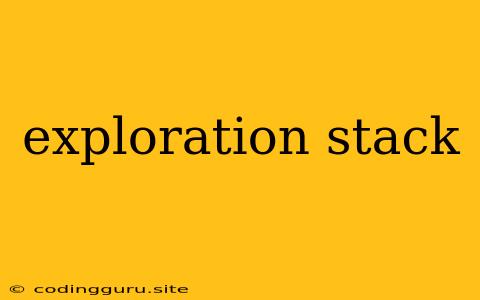Unlocking the Secrets of the Exploration Stack
The exploration stack is a fundamental concept in the realm of machine learning and data science. It refers to a series of techniques and tools used to explore and analyze data before building a predictive model. This initial exploration phase is crucial for understanding the data's structure, identifying patterns, and discovering insights that inform the model development process.
Why is the exploration stack so important? Imagine you're embarking on a scientific expedition. You wouldn't simply start digging without first understanding the terrain, its potential resources, and the challenges you might encounter. Similarly, diving into data without a proper exploration stack can lead to wasted time, flawed models, and inaccurate conclusions.
Essential Components of the Exploration Stack
The exploration stack encompasses a diverse set of tools and techniques, each playing a vital role in unraveling the data's secrets. Here are some key components:
1. Data Acquisition and Cleaning:
- Data Acquisition: The first step involves gathering the data from various sources, which can range from databases to APIs and even text files. This step requires careful consideration of data quality and consistency.
- Data Cleaning: Real-world data is often messy and incomplete. Data cleaning techniques like handling missing values, removing duplicates, and transforming data types are essential to ensure accuracy and reliability.
2. Exploratory Data Analysis (EDA):
- Descriptive Statistics: This involves calculating basic measures like mean, median, mode, standard deviation, and quantiles to understand the distribution and characteristics of the data.
- Visualization: Visualizing data through charts, graphs, and histograms is crucial for identifying trends, outliers, and relationships. Popular visualization tools include Matplotlib, Seaborn, and Plotly.
- Feature Engineering: This involves creating new features from existing ones or transforming features to improve model performance. Techniques like binning, scaling, and interaction terms are commonly employed.
3. Data Transformation and Feature Selection:
- Feature Engineering: As mentioned earlier, feature engineering plays a critical role in transforming raw data into meaningful features that contribute to model accuracy.
- Feature Selection: Not all features are created equal. This step aims to identify and select the most relevant features for the model, discarding irrelevant or redundant ones. Techniques like correlation analysis, feature importance, and dimensionality reduction are used.
4. Model Selection and Evaluation:
- Model Selection: The exploration stack helps identify appropriate machine learning models based on the data's characteristics and the problem's nature. Options include linear regression, logistic regression, decision trees, support vector machines, and neural networks.
- Model Evaluation: After model selection, it's essential to evaluate the model's performance using metrics like accuracy, precision, recall, and F1-score. Techniques like cross-validation and holdout sets are employed to ensure the model's generalizability.
Tips for Building a Robust Exploration Stack
- Start with a clear objective: Define the problem you're trying to solve and the insights you're seeking.
- Embrace visualization: Visualizing data helps identify patterns, outliers, and relationships that might be missed by purely numerical analysis.
- Iterate and refine: The exploration stack is an iterative process. Don't be afraid to revisit previous steps and refine your approach based on new insights.
- Utilize libraries and tools: Leverage powerful libraries like Pandas, NumPy, Scikit-learn, and TensorFlow to streamline your workflow.
- Document your process: Keep detailed records of your exploration steps, data transformations, and insights gained. This documentation will be invaluable for future reference and model reproducibility.
Conclusion
The exploration stack is a critical component of any successful data science project. By diligently exploring and understanding the data, you equip yourself with the knowledge and insights to build powerful and accurate machine learning models. The process might seem complex, but by breaking it down into these key components and embracing the iterative nature of exploration, you can unlock the secrets of your data and achieve meaningful results.
